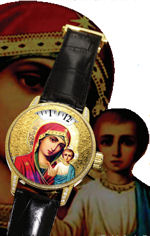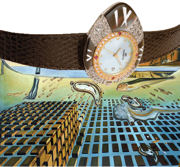Face Value
May 31, 08
So many decisions in life are based on aesthetics. However, we are most critical when it comes to the fine arts. Our judgment of Marcel Duchamp’s “Fountain”, Pablo Picasso’s “Guernica” or Leonardo Da Vinci’s “The Last Supper” is instantaneous. We like it or we don’t. With this in mind, the decision made by some watchmakers to combine fine arts with watches does not seem to be a very profitable or consumer- orientated one.
On the other hand, however, adding to the functionality of watches turns them into “works of art.” A stylish, artistic watch creation is certain to catch the buyer’s eye. Art is understood intuitively rather than rationally, and such watches will draw you to them with their beauty, rather than with their technological features.
In celebration of such an attractive combination, IDEX Magazine takes you on a short journey through art’s romance with watches.
Tribal art, although once seen as crude, primitive pieces of work through the colonialist mentality, has continued to reappear in “European” art throughout the course of history. Post-impressionist artist Paul Gauguin, influenced by his stay in Tahiti, is an example. Vacheron Constantin has followed this trend in its limited edition of four timepieces that represent four different continents (Asia, Africa, Oceania and the Americas). The Metiers d’Art “Les Masques” watch faces include a death mask from China from the Liao Dynasty, a nineteenth century frontal mask from Alaskan Tlingit Indians, a facial mask by either the Mahongwe or Ngare people in Congo’s Brazzaville and an Indonesian facial mask of the Wayang Topeng theatre from the island of Java. These colorful watches come in 18 karat yellow, pink or white gold cases or platinum cases (for the Congo mask).
The Byzantine Empire stretched to such places as Greece, Serbia, 
Bulgaria and Russia, and it’s icon paintings and church architecture
have been maintained until the present day in Eastern Orthodox
countries. This aesthetic tradition has also been preserved in watches
by Angular Momentum, whose Eglomise “The Mother of God of
Tenderness” men’s watchis the epitome of Byzantian art, using
Russian iconography.
Also from Angular Momentum’s “Art meets Art” Eglomise collection are Moghul Miniature watches based on Orientalist art styles. The images are from the Moghul Empire that flourished between the 16th and 17th centuries, and specifically incorporated Persian masters of art in traditional artwork. These watches show the time digitally on a revolving-hour-disk (R.D.S), a time-indication system invented by Angular Momentum in 1997.
From its Beauty and Glamour collection, Swiss company Angular Momentum’s Red Peony is accented with heavy diamond settings with 4 carats of VVS brilliants. The miniature paintings on the reverse side of the sapphire crystal are of different colored peony flowers, known in China as the queen of flowers due to its vibrancy. This collection is of impressionist style and lives up to Angular Momentum’s description of their watches as “representing a life style that combines aesthetics, functionality and technology,” making it stand out from other brands.
More modern art styles such as Surrealism and Pop Art are interpreted into watch designs by companies like Zannetti, Helios Watches and Jacob & Co. Zannetti’s attractive, egg-shaped, handmade watch “Ovum” is a unique timepiece imitating the ovular shape used in some of Salvidor Dali’s artwork. Dali’s famous work, “The Persistence of Memory,” in which drooping clocks are softly melting, looks so real . Zannetti similarly takes shapes and makes them “look as if they would materialize themselves into a functional article.” Integrating Italian creativity and constructional demands, this unique watch comes in 18 karat gold, with sapphires, mother of pearl, rubies and approximately 0.48 carats of brilliant diamonds. 
Cubism, pioneered by Picasso, preceded Surrealism but is widely used today commercially, and by contemporary artists who draw from it style-wise and theoretically. Helios Watches’ Oceanus collection, although inspired by the Greek and Roman God, consists of a TV-modeled case that resembles the Cubist style. The Classic Oblongus case displays the oblong broken up, analyzed and re-assembled at seemingly random angles, in keeping with Cubist thinking.
Jacob & Co.’s Five Time Zone Watch is uncannily similar to Dutch painter Piet Mondrian’s work. Mondrian’s most commonly known abstract artworks generally consist of blue, red and yellow block colors with black dividing lines. This composition is repeated in Jacob & Co.’s watch with each time zone displayed on a different color. The straps are also available in red, blue, yellow or black deployment buckle straps.
Another example of the integration of fine arts with watches is the 
Nothing Special collection by Andy Warhol 15. The collection is
intentionally meant to “blur the lines between art and commerce.”
like Pop artist Andy Warhol himself. Warhol’s artwork has been
turned into “Nothing Special,” emphasizing his cultural legacy and
stressing production over creation. In fact, this creative watch retails
for a mere $35, another critical dimension added by Andy Warhol 15.
Inspired by the Art Deco period, “Lord Waltham” by Waltham watchmakers has smooth lines reminiscent of the popular international design movement of the late 1920s and 1930s. The purely decorative amalgam of different styles and movements of Art Deco is included in the watch design fusing precision with modernism with classic elegance. The brown calf leather strap and brown dial of the watch highlight the influence of Art Deco not only on fine arts but on architecture, fashion, furniture, film, jewelry and, in this case, horology.

Finally, reminiscent not of fine arts, but of architecture is the Limelight Paris-New York watch by Piaget, According to Piaget “the monuments of these two cities, representing authentic architectural icons, feature clearly identifiable and highly stylized motifs.” With focus on the Statue of Liberty in New York, this diamond pave watch imitates the seven rays of the monument’s diadem, symbolizing seven oceans, and perfectly combines art with timepieces.